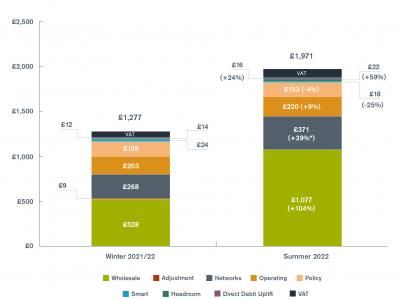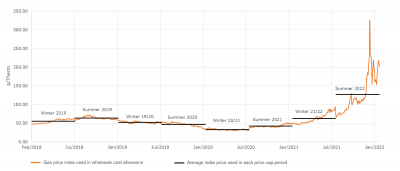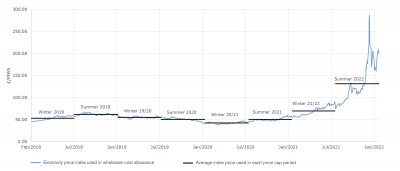Price cap to increase by £693 from April
3 Feb 2022 04:09 PM
The energy price cap will increase from 1 April for approximately 22 million customers. Those on default tariffs paying by direct debit will see an increase of £693 from £1,277 to £1,971 per year (difference due to rounding). Prepayment customers will see an increase of £708 from £1,309 to £2,017.
- Record increase in global gas prices sees energy price cap rise of 54%
- Ofgem knows this rise will be extremely worrying for many people
- Customers struggling to pay their energy bill should contact their supplier to access the help available
The increase is driven by a record rise in global gas prices over the last 6 months, with wholesale prices quadrupling in the last year.
It will affect default tariff customers who haven’t switched to a fixed deal and those who remain with their new supplier after their previous supplier exited the market.
The price cap is updated twice a year and tracks wholesale energy and other costs.
It stops energy companies from making excessive profits, ensuring customers pay no more than a fair price for their energy.
The price cap allows energy companies to pass on all reasonable costs to customers, including increases in the cost of buying gas.
Since the price cap was last updated in August, the current level does not reflect the unprecedented record rise in gas prices which has since taken place.
Under the price cap mechanism, energy companies will be allowed to pass on these higher costs from April when the new level takes effect.
This is because energy companies cannot afford to supply electricity and gas to their customers for less than they have paid for it.
Over the last year, 29 energy companies have exited the market or been put in special administration in the wake of soaring global gas prices, affecting around 4.3 million domestic customers.
Jonathan Brearley, chief executive of Ofgem, yesterday said:
“We know this rise will be extremely worrying for many people, especially those who are struggling to make ends meet, and Ofgem will ensure energy companies support their customers in any way they can.
“The energy market has faced a huge challenge due to the unprecedented increase in global gas prices, a once in a 30-year event, and Ofgem’s role as energy regulator is to ensure that, under the price cap, energy companies can only charge a fair price based on the true cost of supplying electricity and gas.
“Ofgem is working to stabilise the market and over the longer term to diversify our sources of energy which will help protect customers from similar price shocks in the future.”
Ofgem will today announce further measures to help the energy market weather future volatility by increasing financial resilience and have the flexibility to respond so that risks are not inappropriately passed on to consumers. This follows measures announced in December.
The further measures include enabling Ofgem to update the price cap more frequently than once every 6 months in exceptional circumstances to ensure that it still reflects the true cost of supplying energy.
Notes to Editors
1. Help available for customers:
- If customers are struggling to pay for energy bills, they should contact their energy supplier as soon as possible. Depending on their circumstances, customers may be eligible for extra help with their energy bills or services, such as debt repayment plans, payment breaks, emergency credit for prepayment metered customers, priority support and schemes like the Winter Fuel Payment or Warm Home Discount rebate.
- Breathing Space Scheme: This is a scheme to give households time to receive debt advice and find a solution to sort out their debt problems. Breathing space will last for 60 days as long as applicants remain eligible during which time all creditors who have been included will be informed and must stop any collection or enforcement activity. Once the breathing space ends, creditors will be able to collect the debt in the usual way. Call the National Debtline on Freephone 0808 808 4000 or visit www.nationaldebtline.org
- The Citizens Advice consumer service can provide advice on how customers can resolve problems with their energy provider. You can contact Citizens Advice via webchat, or by calling 0808 223 1133. For complex or urgent cases, or if a person is in a vulnerable situation, they may then be referred onto the Extra Help Unit.
2. Ofgem will announce further measures tomorrow including:
- Introducing an uplift in the wholesale cost allowance in the price cap: after reviewing the evidence, Ofgem has decided that the existing price cap methodology did not appropriately account for the additional wholesale energy costs energy companies have incurred during the current price cap period following the unprecedented scale of wholesale energy prices and volatility. This adjustment represents less than 10% of the overall price cap increase.
- Changing licence conditions to give Ofgem the more flexibility to change the price cap level if needed in between the regular six-monthly cap updates: Ofgem has set ourselves five tests which mean we will only expect to use the power in exceptional circumstances.
- Further reforms to the price cap from October: In December we set out three options to make the price cap more robust to high and volatile wholesale energy costs while preserving as far as possible the benefits of the price cap for consumers. The consultation published tomorrow will include all three options, with quarterly updates as our preferred option
3. The price cap protects around 22 million households on default or variable rates on credit meters. The £1,971 per year level of the cap is based on a household with typical consumption on a dual electricity and gas bill paying by direct debit. Customers who pay by standard credit (cash or cheque) pay an additional £130 based on the higher cost for energy companies to serve them. The 22 million households protected by the price cap includes around 4.5 million prepayment meter customers. These customers pay an additional £47 compared to those on direct debit, which also reflects the higher cost for energy companies to serve them. The values shown in the text above include VAT and are expressed for the current Typical Domestic Consumption Values (TDCV) of 2,900kWh of electricity, 12,000kWh of gas, and 4,200kWh of electricity for Economy 7. The price cap is a cap on a unit of gas and electricity, with standing charges taken into account. It is not a cap on customers’ overall energy bills, which will still rise or fall in line with their energy consumption. From 1 April the equivalent per unit level of the price cap to the nearest pence for a typical customer paying by direct debit will be 28p per kWh for electricity customers and 7p per kWh for gas customers
4. Breakdown of costs in the energy price cap
Dual fuel customer paying by direct debit, typical energy use (GB £)

*Network costs: The main driver of this increase is the recovery of Supplier of Last Resort (SoLR) levy costs (£68). A supplier acting as a SoLR can make a claim for any reasonable additional, otherwise unrecoverable, costs they incur. These levy claims are paid to energy companies by the distribution network companies and recovered from consumers via their charges.
5. The charts below show the wholesale prices that are used to determine the wholesale cost allowance within the price cap from spring 2018 ahead of the introduction of the price cap in January 2019. Wholesale costs make up the majority of a customer’s bill. An efficient supplier will purchase energy for their customers on the wholesale market in advance of when they need to supply that energy. This purchasing strategy is reflected in how the wholesale allowance is calculated within the price cap. We observe the forward-looking energy contracts that energy companies typically purchase over time and combine these to determine the wholesale cost allowance within the price cap. We do this twice a year when we update the price cap in August for the winter period (October - March) and in February for the summer period (April - September) based on the price of these forward-looking energy contracts over the previous six months. The fixed horizontal line shows the average wholesale cost allowance for each 6 month price cap period based on the price of the relevant forward looking energy contracts (the jagged line). The recent spike in the prices of relevant forward looking energy contracts over the last 6 months can be clearly seen. The scale and pace of wholesale price increases has resulted in a big increase in the wholesale cost allowance for the price cap level for summer 2022.
Wholesale gas price costs in the energy price cap
Pence per therm

Wholesale electricity price costs in the energy price cap
Pounds per megawatt hour

Data sets behind these graphs are proprietary and can be sourced from ICIS.
6. Information and materials for consumers about the price caps is available at: www.ofgem.gov.uk/energy-price-caps. Information on support and advice for consumers worried about paying their bills is available at: www.ofgem.gov.uk/help-with-bills
Media enquiries
Please email press@ofgem.gov.uk or 0203 263 9996.
General enquiries (non-media)
If you are an energy customer looking for help and advice, including complaints about energy firms, please see our Household gas and electricity guide. Citizens Advice also provide a free, impartial helpline service across a range of issues on 0808 223 1133.
We also regularly share news and post general advice to help consumers get the most out of their energy services via our @Ofgem twitter and Facebook pages. If you have an enquiry or complaint relating to Ofgem’s policies or functions, contact us at consumeraffairs@ofgem.gov.uk or on 020 7901 7295.
For all other non-media related enquiries, please visit our Contact us page.
About Ofgem
Ofgem is Britain’s independent energy regulator. Our role is to protect consumers now and in the future by working to deliver a greener, fairer energy system. We do this by:
- Working with Government, industry and consumer groups to deliver a net zero economy at the lowest cost to consumers.
- Stamping out sharp and bad practice, ensuring fair treatment for all consumers, especially the vulnerable.
- Enabling competition and innovation, which drives down prices and results in new products and services for consumers.
For facts, figures and information about Ofgem’s work, see Energy facts and figures or visit the Ofgem Data Portal.
For energy insights and updates straight to your inbox from Ofgem, please subscribe.
Follow us on Twitter @ofgem, LinkedIn and Facebook.